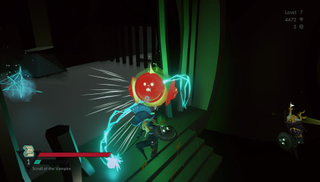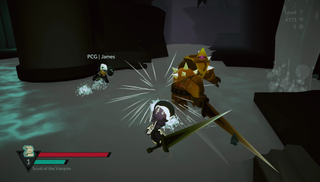Our Verdict
Ghoulish creature design and fun combat are weakened by long boring stretches, clueless AI, and snickering obscurity.
PC Gamer's got your back
What is it: An action RPG with procedurally generated levels and permadeath.
Reviewed on: Windows 10, 8GB RAM, Core i5-3570, GeForce GTX Titan
Price: $30/£23
Release date: Out now
Publisher: Harebrained Schemes
Developer: Harebrained Schemes, Bandai Namco
Multiplayer: 4-player co-op
Link: http://necropolisgame.com/
I was so green last Saturday, dying on the first level because a spider bit me, puking up rotten food in the middle of a fight, running terrified from screaming bearded slobs. Necropolis starts under thick obscurity: You’re dropped into a deep supernatural dungeon with a crappy sword, a crappy shield, no instructions beyond the controls, and little hope of surviving. But through repetition—sometimes very dull repetition—you can become godlike.
Each level of the titular Necropolis is procedurally generated. The first couple floors are simple mazes of samey grey rooms, but as you descend on floating elevators, you’ll start finding open air bits and swamps full of horrible marauders and monsters, all gruesomely creative. Clearing each level requires finding the next elevator room and surviving the many creatures in the way. If you die, it’s back to the first floor to start all over.
I’ve died on the sixth floor three times after spending over an hour en route. As I write I’m safely saved on the eighth floor. I think there are ten, but only those who designed it or who've beat it know for sure. It’s all very mysterious.

Hack 'em up
Well-developed Dark Souls skills will help in mastering Necropolis’ third-person combat, but it's more forgiving and Zelda-like. Timing and stamina management are in play, but the basic enemies aren’t especially dangerous on their own, and you won’t be dodging mile-long greatswords from bosses. You lock onto the reasonably-sized beasts and chain light attacks, heavy attacks, shield bashes, blocks, and dodges. You can also charge and release special light and heavy attacks, spiraling your weapon broad arcs and smashing the ground for area damage, but they’re a stylish last ditch effort—not only do specials drain a ton of stamina, too much exertion lowers your maximum stamina, which can only be recovered by eating a ration or drinking the right potion. If your stamina falls to half you can barely swing your sword to defend yourself, and there's a good chance you'll die if you stop to munch on a turkey leg.
It’s either a cakewalk or it’s harrowing.
Against most individual enemies—your skeletons, your mad acolytes, your toad monsters—you can whack away pretty carelessly and survive. It’s when you’re reeling in a kite of eight or more slobbering beasts that fear sets in. Several times I’ve been set upon by giant charging hordes, backed into a corner, camera peering straight down into a mess of limbs (the camera sucks in tight spaces, as cameras usually do), praying I can charge a special attack without being knocked out of the animation. Slicing up a mound of enemies, then facing the last, strongest one with a sliver of health left is thrilling.
But after 14 hours of practice, I’m now either making easy work of the hordes on the first five-or-so levels, or being mobbed and chewed up by the more vicious beasts of level six and beyond. There’s not much of an in-between after climbing that initial, steep skill mountain—it’s either a cakewalk or it’s harrowing. As a result, the first half of Necropolis is getting very, very old, and all I want to do is take on the latter half where I have more to learn. But we’re in roguelike country now, and it’s all our fault for saying Spelunky was good—damn us.

Mysteries of the deep
The story of the Necropolis doesn’t really help keep the repetition interesting: a talking pyramid and inscriptions on the walls tell its tale in short quips, with Zork-like gags about dying adventurers and petty gods that you’ll see again and again. They’re funny sometimes, in a Christopher Moore or Douglas Adams sort of way, but while Necropolis lampoons serious fantasy it doesn’t build an interesting fantasy of its own. Where Devil Daggers wordlessly feels like the product of a mysterious floppy disk ‘90s teenagers discovered in an occult bookstore, Necropolis’ self-aware one liners are more of a cutesy wink and a shrug—something to be ignored.
And the snickering mysteries can be frustrating. Combat skills are only half of survival: You’ve also got to collect loot and unlock codices, the latter of which carry over between runs. Equipping a codex sets some kind of modifier, but it’s hard to know what most of them do. Early on I spent a handful of hard earned points to unlock “The best defense… is a good defense (stupid)” and I still have no idea how equipping it helps me. Later I saved up for one that references vampirism, because in a videogame that’s always going to leech enemy health in some way, and I haven’t bothered with any others. I don’t want to waste a run being the butt of a joke, trying to decipher someone’s tongue-in-cheek item description.
It’s a little too cute, and that crypticness also applies to weapons and shields, for which there are no visible stats except a tier level. To be fair, part of Necropolis’ fun is in deciphering its obscurities, but it’s tough to want to experiment when you’ve spent an over an hour getting to where you are and death will set you back to the boring, grey first level.

Secrets between friends
In online co-op (up to three other players can join your run in progress, wherever you are), Necropolis is much more fun—actually, I don't recommend it as a single-player game at all. Its mysteries are best shared, and I had a good time combining knowledge with a partner, comparing tips on enemy behavior, splitting rations, and searching for chests and secret passages. Co-op also mitigates Necropolis’ cruelty, because as long as one player remains alive they can revive the others.
Team wipes will happen, of course, especially because co-op adds a new dimension of cruelty: team damage. I appreciate the layer of caution that adds, but being able to accidentally kill cohorts encourages meek, nipping strikes. After my teammate unleashed a special move just as I went to help him and accidentally stomped me into dust, we changed tactics so that one person fought up front, while the other waited around for them to retreat to attack the kited enemies from behind—which is easy to do because they won’t change targets once locked onto a player.
Enemies also tend to get stuck on things, and if you’re lucky enough to find a crossbow you can stand at a distance and shoot them until they die—they won’t move. To some extent, beating Necropolis is about studying the AI quirks and learning how to activate as few enemies as possible at a time, timidly luring them to their deaths. Victory is slow and methodical.
Also, watch out behind you: Necropolis loves to pop enemies into rooms you've already cleared so they can sandwich you. That's just rude, and a crappy way to die.

A lot of the fun rests on the procedural generation creating surprises and interesting challenges—that aren't just surprise enemy spawns—but the randomization can generate boredom just as well as excitement. A friend and I spent two hours on levels five through seven mostly trundling through emptiness, opening chests full of the same few drops (I’ve only found a few really good weapons) and killing easy prey. There’d be a burst of action, and we’d get walloped by a guy with an ice axe, but then we’d freeze him for slaughter with a paralysis scroll and go back to wandering into empty dead ends.
Plenty of other moments throughout my attempts have been exciting: cutting through a Serious Sam-style monster rush, chanting an unidentified spell in a panic and finding out it does exactly what I need it to, finding a sword that one-hits the enemies I was struggling with just a minute ago. I love transforming fear into confidence and mastering the obscure—how formerly scary skeletons are now puny bone piles to me. But when I hit a boring stretch on a lower level, get impatient, make a mistake, and die, I'm not thrilled to have to go back to slashing even more boring bones at the beginning.
There’s probably some arcane method for skipping levels, or at least running them faster, but I haven’t found it yet. As exasperating as Necropolis’ secretiveness can be, I do like that it rekindles the pre-internet days of word-of-mouth game lore. I’m sure I’m missing many secrets that are soon to be written in guides and FAQs. If you play Necropolis, play it before it's been fully documented, with friends who want to discover it with you—and tell me what all the codices do if you can.
Ghoulish creature design and fun combat are weakened by long boring stretches, clueless AI, and snickering obscurity.

Tyler grew up in Silicon Valley during the '80s and '90s, playing games like Zork and Arkanoid on early PCs. He was later captivated by Myst, SimCity, Civilization, Command & Conquer, all the shooters they call "boomer shooters" now, and PS1 classic Bushido Blade (that's right: he had Bleem!). Tyler joined PC Gamer in 2011, and today he's focused on the site's news coverage. His hobbies include amateur boxing and adding to his 1,200-plus hours in Rocket League.

HP spends big to secure title sponsorship rights for the Ferrari Formula One team

After 6 years, the FCC has voted to restore net neutrality regulations in a win for the open internet

Hasbro says Magic: The Gathering's Fallout-themed Commander cards were 'probably our best-performing Commander set ever'
